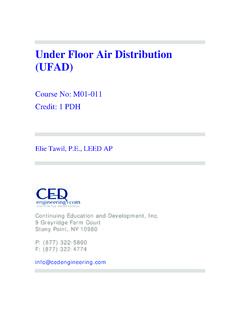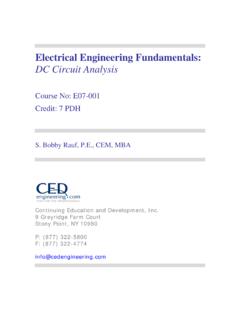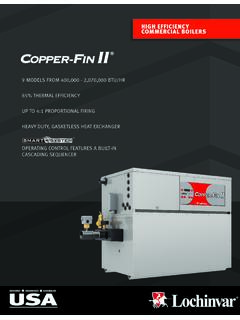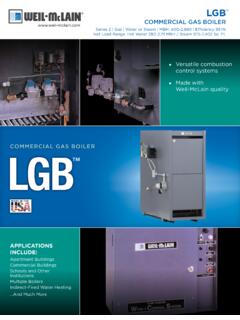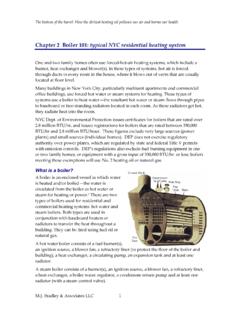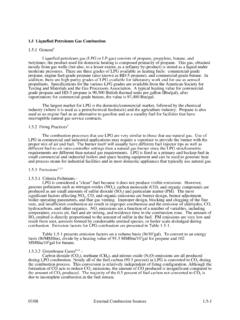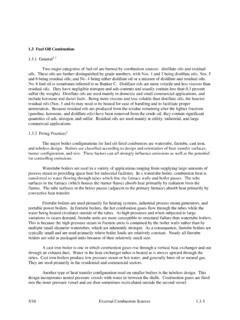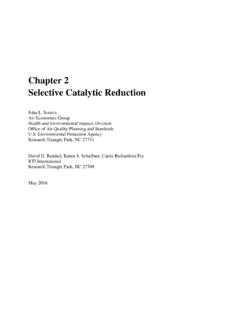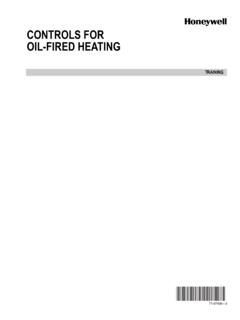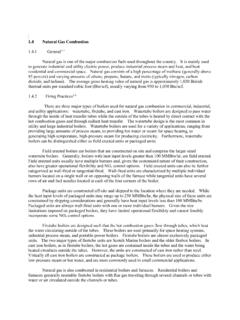Transcription of Boiler Classification and Application - CED Engineering
1 Boiler Classification and Application Course No: M02-027 Credit: 2 PDH Elie Tawil, , LEED AP Continuing Education and Development, Inc. 9 Greyridge Farm Court Stony Point, NY 10980 P: (877) 322-5800 F: (877) 322-4774 2-12. INDUSTRIAL, COMMERCIAL, AND INSTITUTIONAL BOILERSC ombustion boilers are designed to use the chemical energy in fuel to raise the energy content ofwater so that it can be used for heating and power applications. Many fossil and nonfossil fuels are firedin boilers, but the most common types of fuel include coal, oil, and natural gas.
2 During the combustionprocess, oxygen reacts with carbon, hydrogen, and other elements in the fuel to produce a flame and hotcombustion gases. As these gases are drawn through the Boiler , they cool as heat is transferred to the gases flow through a stack and into the atmosphere. As long as fuel and air are bothavailable to continue the combustion process, heat will be are manufactured in many different sizes and configurations depending on thecharacteristics of the fuel, the specified heating output, and the required emissions controls. Some boilersare only capable of producing hot water, while others are designed to produce steam.
3 Various studieshave been conducted to estimate the number of boilers in the United States, but no data source provides acomplete representation of the existing Boiler the United States, boilers are typically designed and constructed as either power or heatingboilers in accordance with applicable requirements adopted by the American Society of MechanicalEngineers (ASME). Rules for power boilers are provided in Sect. I of the ASME Boiler and PressureVessel These rules apply to steam boilers that operate above 15 psig and hot water boilers thatoperate above 160 psig or 250 F.
4 Common design pressures are 150, 200, 250, and 300 psig, but higherpressures are possible. 3 For example, boilers for certain pulp and paper industry applications are nowdesigned for pressures as high as 1,500 psig. Corresponding rules for heating boilers are provided inSect. According to these rules, heating boilers that produce hot water are not allowed to operateabove 160 psig or at temperatures above 250 F at or near the Boiler outlet. Additional rules limit heatingboilers that produce steam to a maximum operating pressure of 15 boilers with heat input capacities more than 250 million British thermal units per hour(MBtu/h) are classified as utility boilers because they are used at power plants to produce boilers of this size are also used at paper mills and institutions and for other industrial boilers with less capacity are categorized as ICI boilers.
5 Industrial boilers are used extensively bythe chemical, food processing, paper, and petroleum industries. They have heat input capacities up to andsometimes more than 250 MBtu/h. Commercial and institutional boilers are used in many otherapplications including commercial businesses, office buildings, apartments, hotels, restaurants, hospitals,schools, museums, government buildings, and the past when emissions were less regulated, choosing the right Boiler and combustion equipmentfor a particular Application generally involved matching the process requirements with the Boiler s outputcapacity.
6 Proper sizing and selection required knowledge of the peak process requirements and anunderstanding of the load profile. This Boiler selection philosophy emphasized energy conversion at thelowest possible cost. Reduced emphasis was placed on controlling emissions. Public concerns about airand water quality and enactment of federal, state, and local regulations have shifted this emphasis. Thecurrent design objective is to provide low-cost energy with an acceptable impact on the environment. Asdiscussed in an Engineering manual published by ABMA, control of PM, NOx, CO, and SO2 emissions isnow a significant consideration in the overall Boiler and combustion equipment design and TYPES OF ICI BOILERSI nformation in this guide focuses primarily on a broad class of steam and hot water generating unitsknown as ICI boilers.
7 Because of differences in their features and characteristics, ICI boilers can beclassified in at least three Boilers are commonly subdivided into watertube or firetube units. These designations reflect the waythe water and combustion gases are designed to pass through the unit. Boilers are sometimes classified by their heat sources. For example, boilers are often referred to asoil- fired , gas- fired , coal- fired , or solid fuel- fired boilers. Coal- fired boilers can be further dividedbased on the equipment used to fire the Boiler . The three major coal- fired Boiler subclasses arepulverized-coal (PC) fired , stoker- fired , and fluidized-bed combustion (FBC) boilers.
8 Boilers are occasionally distinguished by their method of fabrication. Packaged boilers are assembledin a factory, mounted on a skid, and transported to the site as one package ready for hookup toauxiliary piping. Shop-assembled boilers are built up from a number of individual pieces orsubassemblies. After these parts are aligned, connected, and tested, the entire unit is shipped to thesite in one piece. Field-erected boilers are too large to transport as an entire assembly. They areconstructed at the site from a series of individual components. Sometimes these components requirespecial transportation and lifting considerations because of their size and basic purpose of any ICI Boiler is to convert the chemical energy in fuel into thermal energythat can be used to generate steam or hot water.
9 Inside the combustion chamber, two fundamentalprocesses must occur to achieve this objective. First, the fuel must be mixed with sufficient oxygen toallow sustained combustion. The heated gases produced by the combustion process must then transfer thethermal energy to a fluid such as water or steam. Various components inside the Boiler are required topromote efficient combustion and heat transfer. Their design depends on factors such as the type of fueland the method selected to transfer thermal ICI boilers are manufactured in a wide range of sizes to burn coal, oil, natural gas, biomass, andRDFs as well as other fuels and fuel combinations.
10 Most ICI boilers are classified as either watertube orfiretube boilers, but other designs such as cast iron, coil-type, and tubeless (steel shell) boilers are alsoproduced. Descriptions of some of the more typical Boiler designs are presented below. Additional detailsabout ICI boilers and their design, construction, and operation are available from other ,5 Firetube BoilersFiretube boilers consist of a series of straight tubes that are housed inside a water-filled outer tubes are arranged so that hot combustion gases flow through the tubes. As hot gases flow throughthe tubes, they heat the water that surrounds the tubes.

